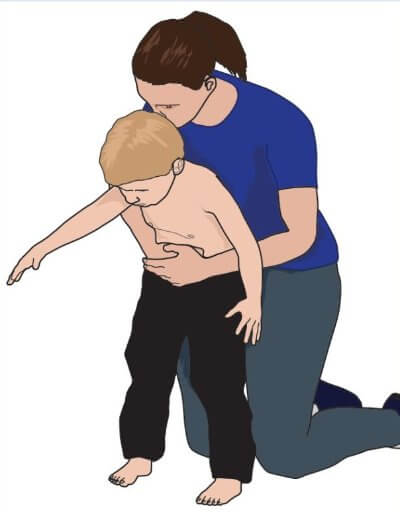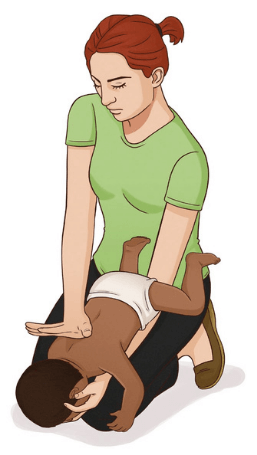5.2 Child and Infant Choking
Children and infants are at higher risk of choking due to smaller airways and a tendency to put objects in their mouths. Choking can escalate quickly into a life-threatening emergency, so immediate and age-appropriate intervention is critical.
Child and Infant Choking
Responsive Child (Age 1 to Puberty)
Signs of severe airway obstruction in children include inability to speak or breathe, high-pitched or no sounds, and panic. If the child is responsive but choking:
- Ask: “Are you choking?” and get permission to help (from the child or guardian).
- Perform abdominal thrusts (Heimlich maneuver):
-
Stand or kneel behind the child,
depending on their height.×Stand or kneel behind the child,
 © FAW Training Solutions – All rights reserved
© FAW Training Solutions – All rights reserved - Place your fist just above the navel, grasp with your other hand.
- Deliver quick, upward abdominal thrusts.
-
Stand or kneel behind the child,
- Continue until the object is expelled or the child becomes unresponsive.
Unresponsive Child
If the child becomes unresponsive:
- Lower them gently to the ground and call 911 or activate emergency response.
- Begin CPR immediately, starting with chest compressions.
- Check the airway after compressions. If you see the object, carefully remove it.
- Do not perform a blind finger sweep—only remove visible obstructions.
Responsive Infant (Under 1 Year)
Infants may exhibit weak cries, ineffective coughing, or stop breathing altogether. If an infant is choking but responsive:
- Hold the infant face-down along your forearm, supporting the head and neck.
-
Deliver 5 back slaps (sometimes called “back blows”)
between the shoulder blades using the heel of your hand.×Deliver 5 back slaps (sometimes called “back blows”)
 © FAW Training Solutions – All rights reserved
© FAW Training Solutions – All rights reserved - Turn the infant face-up, keeping the head lower than the chest, and
give 5 chest thrusts
using two fingers just below the nipple line.×give 5 chest thrusts
 © FAW Training Solutions – All rights reserved
© FAW Training Solutions – All rights reserved - Alternate back slaps and chest thrusts until the object is expelled or the infant becomes unresponsive.
Unresponsive Infant
- Place the infant on a firm, flat surface and call 911 or activate emergency response.
- Begin CPR, starting with chest compressions.
- Each time you open the airway, look for the object and remove it if visible.
- Do not attempt a blind finger sweep in an infant.
Prompt recognition and age-appropriate intervention during choking emergencies can mean the difference between life and death. Always stay calm, act quickly, and call for help early.